
NOW Articles Written By Members
An Argument for Collecting Half Dollars
Late Night and a Russian Type Set
Old Country Coins: Newfoundland’s Rarest 5-Cent
Milwaukee Medals: Fifth Ward Constable
A look back at a common, but classic commemorative – Wisconsin’s Territorial Centennial
A side-tracked story: Mardi Gras Doubloons
A look back at a collecting specialty – the O.P.A. ration tokens of WWII
Bullion And Coin Tax Exemption – Act Now!
Is There A Twenty Cent Piece We Can Add To A Collection
Capped Bust Half Dollars: A Numismatic Legacy
U.S. Innovation Dollars: Our Most Under-Collected Coin?
My 2023 ANA Summer Seminar Adventure
>> More articles in the Archive
For more NOW Articles Written By Members,
Walhalla
By Lee Hartz #1219
The Walhalla is a hall of fame that honors laudable and distinguished people and famous personalities in German history – politicians, sovereigns, scientists and artists of the German tongue. The hall is housed in a neo-classical building above the Danube River, east of Regensburg, in Bavaria, Germany.
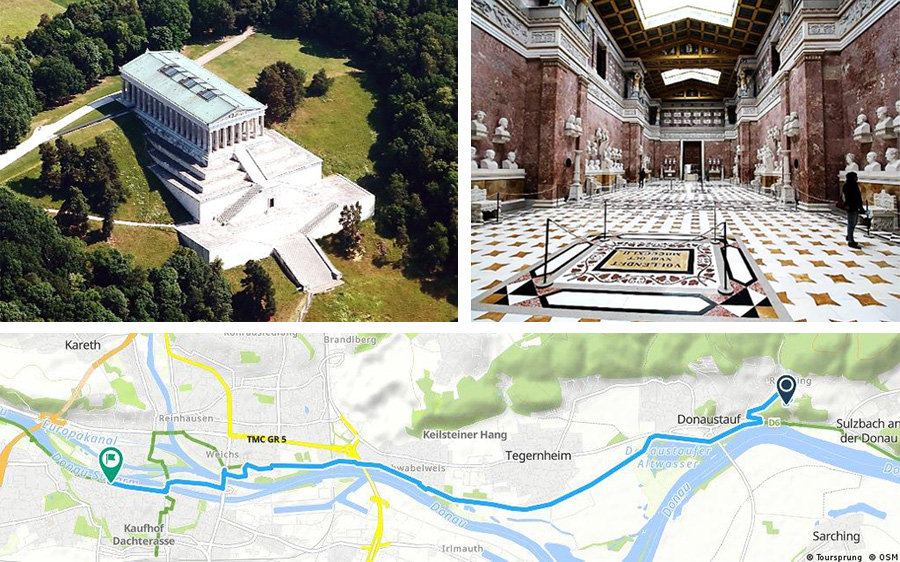
The Walhalla is named for Valhalla of Norse mythology. (Valhalla was a mythical hall that was the sacred resting place for slain Norse warriors) Walhalla was conceived by Crown Prince Ludwig in 1807, who built it upon ascending the throne of Bavaria as King Ludwig I. Construction took place between 1830 and 1842, under the supervision of architect Leo von Klenze. The exterior is 246 feet long by 115 feet wide and is surrounded by 52 Doric columns. The interior consists of a hall 157 feet long, 46 feet wide, and 52 feet high.
The memorial displays some 65 plaques and 130 busts of persons, covering 2,000 years of history – the earliest person honored is Arminius, victor at the Battle of the Teutoburg Forest (9 AD).
History
By 1806 Napoleon's First French Empire had annexed German lands along the Rhine River and the North Sea. Central German states formed the Confederation of the Rhine, which sided with Napoleon. Francis II, Holy Roman Emperor, then formally dissolved the Holy Roman Empire of the German Nation (6 August 1806) and instead styled himself Emperor of Austria. The War of the Fourth Coalition (1806-1807) pitted German forces on both sides against each other, and Napoleon again prevailed.
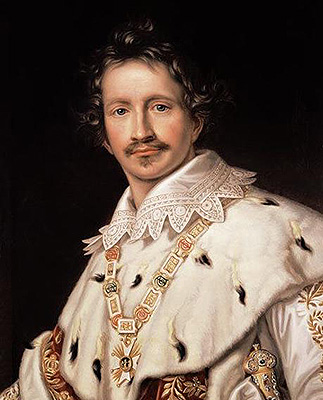
Ludwig I of Bavaria
In 1807, 20-year-old Crown Prince Ludwig of the Kingdom of Bavaria (newly elevated from Electorate to Kingdom by Napoleon in 1806), had the idea of reminding all Germans of their common heritage – of the great figures and events in ethnic German history. He commissioned several sculptors to create busts of famous individuals of his choice. Johann Gottfried Schadow's bust of Nicolaus Copernicus became one of the first completed, in 1807. Further suggestions for individuals to be honored were solicited in 1808 from Swiss historian Johannes von Müller.
By the time of Crown Prince Ludwig's coronation as King Ludwig I of Bavaria in 1825, 60 busts had been completed. In 1826 Ludwig commissioned the construction of a memorial above the Danube River, near Regensburg, modeled after the Parthenon in Athens. The southern pediment frieze features the 1815 creation of the German Confederation: the northern, scenes from the Battle of the Teutoburg Forest of 9 AD. According to Pictorial Travels Continentally Described (circa 1892), the construction of the building cost £666,666.
At Walhalla's inauguration on October 18, 1842, there were 96 busts, plus 64 plaques for persons or events of which no portrait was available on which to model a sculpture. As being "of the German tongue" was the main selection criterion for the original 160 persons representing the 1,800 years of German history, the King included persons from, or who had been active in, modern-day Sweden, Austria, Czech Republic, Poland, United Kingdom, Belgium, Netherlands, Russia, Switzerland and the Baltic States.
Whereas the Valhalla of Norse mythology served as home to those gloriously slain in battle, Ludwig intended his Walhalla not only for warriors but also for scientists, writers, and clerics, and specifically included both men and women. Decades before the foundation of the German Empire in 1871, "German" was understood as "Germanic". Included were Gothic, Langobardic, Anglo-Saxon, Austrian, Dutch and Swiss German figures, as well as persons who had gained fame mainly in other countries or while serving non-German governments.
As successor to the King, the government of Bavaria decides on additions. Anyone may propose a name, but candidates must have died at least 20 years before becoming eligible (10 years, prior to 1912). Only 31 busts have been added since its opening, on an irregular basis, for a total of 191, twelve of them female.
In Munich, King Ludwig I established an additional Hall of Fame for Bavarians in 1853 – the Ruhmeshalle München. Nine of the Bavarian enshrinees have since become Walhalla enshrinees. Thus, their busts in the Ruhmeshalle, which were destroyed in 1944 during World War II, have not been recreated. Instead, a plaque with their names tells of their transfer to Walhalla. Additionally, King Ludwig I, who commissioned the Befreiungshalle and other monuments, is enshrined both at Walhalla and in the Ruhmeshalle.
In 1842, the Kingdom of Bavaria issued a double thaler (3-1/2 Gulden) commemorating the opening of Walhalla. The mintage is not known, but it is somewhat scarce. There was also a medal struck in tin commemorating the opening. I have examples of both the coin and the medal. In addition, I obtained a medal commemorating Prince von Bismarck’s selection into Walhalla in 1908, created by renowned medalist Karl Goetz. The obverse has a portrait of Bismarck with the date 1908, and the reverse is similar to the image from the 1842 coin.
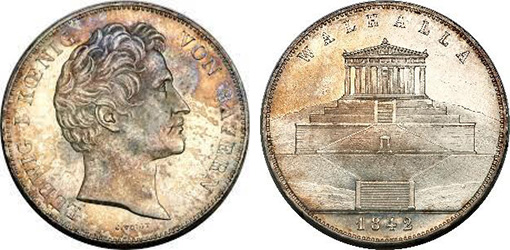
1842 Bavarian Double Thaler. Actual size:37mm
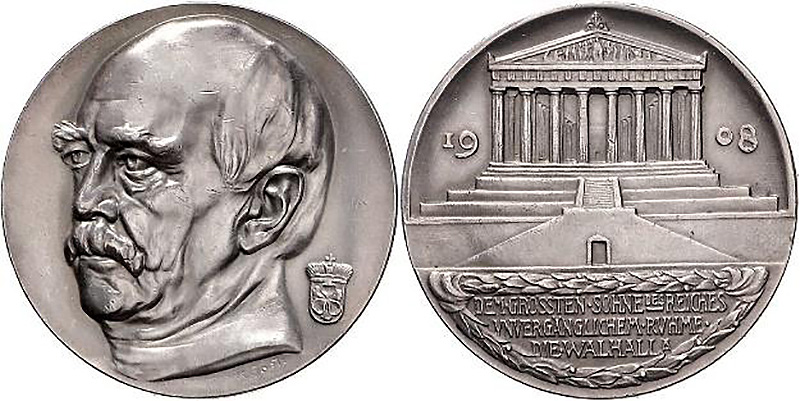
Karl Goetz medal of Otto von Bismarck's induction into Walhalla. Actual size:40mm
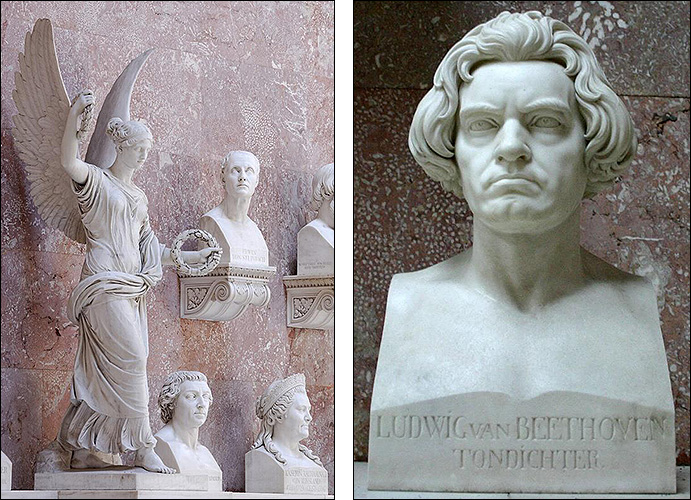
Examples of busts gracing the Walhalla.
I am fortunate to have been able to visit Walhalla on two occasions – alone in 1968 and with my wife in 1989.
The long list of inductees in Walhalla can be viewed with a Google search. It is interesting to note some of the names, from ancient times to the modern era; Visigoth King Aleric I, Physicist Albert Einstein, Inventor Johannes Gutenberg, Composer Ludwig van Beethoven, and Nazi resister Sophie Scholl, to name a few. They are honored with plaques or busts.
Commemorative plaques
Plaques were made for persons (or acts) of which no portraits or descriptions were available to model sculptures after. The timeline spans from Arminius a.k.a. Hermann der Cherusker (born 17 BC) to watchmaker Peter Henlein, who died in 1542. In 2003 a plaque was added to commemorate well-known and unknown German Resistance fighters against Nazi Germany.
Busts
The original busts (before 1847), are arranged in rows by date of death, beginning with Henry the Fowler (died 936 AD) and ending with Goethe (died 1832). Later additions (after 1847) are similarly arranged and begin with Martin Luther (died 1546) to the present.
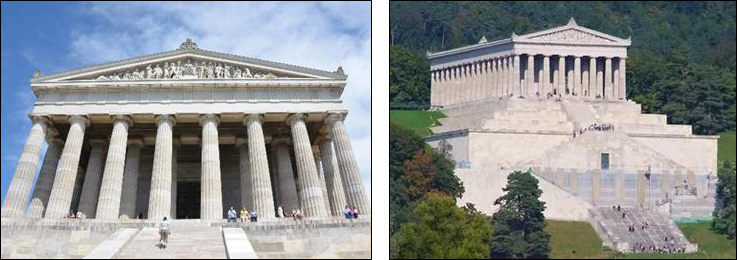
If you are planning a trip to Germany, I strongly recommend a visit to Walhalla.
Have an interesting numismatic topic you’d like to share with your fellow NOW members?
Send your article to evan.pretzer@protonmail.com today!!!